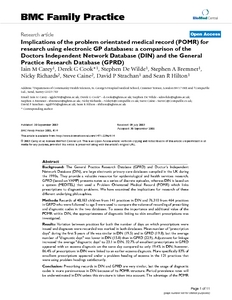Carey, IM; Cook, DG; De Wilde, S; Bremner, SA; Richards, N; Caine, S; Strachan, DP; Hilton, SR
(2003)
Implications of the problem orientated medical record (POMR) for research using electronic GP databases: a comparison of the Doctors Independent Network Database (DIN) and the General Practice Research Database (GPRD).
BMC Family Practice, 4 (14).
ISSN 1471-2296
https://doi.org/10.1186/1471-2296-4-14
SGUL Authors: Carey, Iain Miller Cook, Derek Gordon De Wilde, Stephen Strachan, David Peter
![[img]](https://openaccess.sgul.ac.uk/915/1.hassmallThumbnailVersion/1471-2296-4-14.pdf)  Preview |
|
["document_typename_application/pdf; charset=binary" not defined]
Published Version
Download (387kB)
| Preview
|
Abstract
Background
The General Practice Research Database (GPRD) and Doctor's Independent Network Database (DIN), are large electronic primary care databases compiled in the UK during the 1990s. They provide a valuable resource for epidemiological and health services research. GPRD (based on VAMP) presents notes as a series of discrete episodes, whereas DIN is based on a system (MEDITEL) that used a Problem Orientated Medical Record (POMR) which links prescriptions to diagnostic problems. We have examined the implications for research of these different underlying philosophies.
Methods
Records of 40,183 children from 141 practices in DIN and 76,310 from 464 practices in GRPD who were followed to age 5 were used to compare the volume of recording of prescribing and diagnostic codes in the two databases. To assess the importance and additional value of the POMR within DIN, the appropriateness of diagnostic linking to skin emollient prescriptions was investigated.
Results
Variation between practices for both the number of days on which prescriptions were issued and diagnoses were recorded was marked in both databases. Mean number of "prescription days" during the first 5 years of life was similar in DIN (19.5) and in GPRD (19.8), but the average number of "diagnostic days" was lower in DIN (15.8) than in GPRD (22.9). Adjustment for linkage increased the average "diagnostic days" to 23.1 in DIN. 32.7% of emollient prescriptions in GPRD appeared with an eczema diagnosis on the same day compared to only 19.4% in DIN; however, 86.4% of prescriptions in DIN were linked to an earlier eczema diagnosis. More specifically 83% of emollient prescriptions appeared under a problem heading of eczema in the 121 practices that were using problem headings satisfactorily.
Conclusion
Prescribing records in DIN and GPRD are very similar, but the usage of diagnostic codes is more parsimonious in DIN because of its POMR structure. Period prevalence rates will be underestimated in DIN unless this structure is taken into account. The advantage of the POMR is that in 121 of 141 practices using problem headings as intended, most prescriptions can be linked to a problem heading providing a specific reason for their issue.
| Item Type: |
Article
|
| Additional Information: |
© 2003 Carey et al; licensee BioMed Central Ltd. This is an Open Access article: verbatim copying and redistribution of this article are permitted in all media for any purpose, provided this notice is preserved along with the article's original URL. http://dx.doi.org/10.1186/1471-2296-4-14 |
| Keywords: |
Child, Preschool, Cohort Studies, Databases, Factual, Diagnosis-Related Groups, Drug Prescriptions, Eczema, Emollients, Epidemiologic Studies, Family Practice, Great Britain, Health Services Research, Humans, Infant, Infant, Newborn, Medical Records, Problem-Oriented, Primary Health Care |
| SGUL Research Institute / Research Centre: |
Academic Structure > Population Health Research Institute (INPH) |
| Journal or Publication Title: |
BMC Family Practice |
| ISSN: |
1471-2296 |
| PubMed ID: |
14516473 |
| Web of Science ID: |
14516473 |
  |
Download EPMC Full text (PDF)
|
 |
Download EPMC Full text (HTML)
|
 |
Go to PubMed abstract |
| URI: |
https://openaccess.sgul.ac.uk/id/eprint/915 |
| Publisher's version: |
https://doi.org/10.1186/1471-2296-4-14 |
Statistics
Item downloaded times since 30 Sep 2014.
Actions (login required)
 |
Edit Item |




